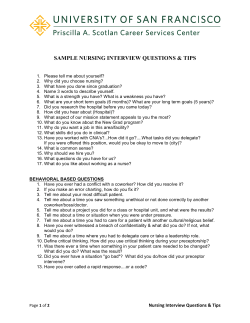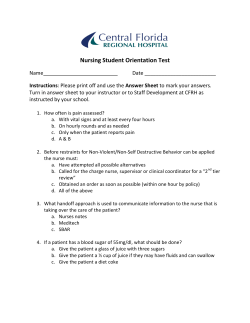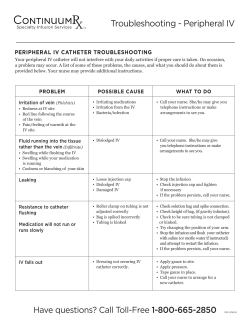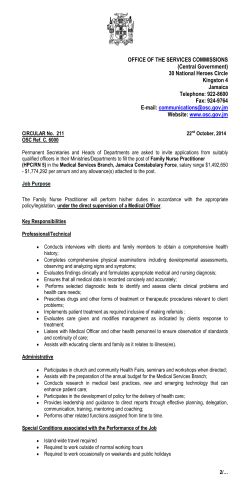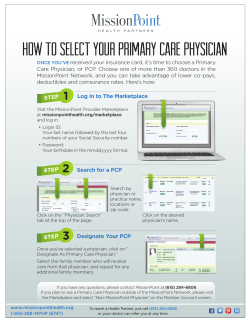
Workflow, time and patient satisfaction from the perspectives of Home Monitoring
Europace (2013) 15, i49–i53 doi:10.1093/europace/eut113 Workflow, time and patient satisfaction from the perspectives of Home Monitoring Renato Pietro Ricci* and Loredana Morichelli Department of Cardiology, San Filippo Neri Hospital, Via Martinotti, 20, Rome 00135, Italy Received 20 March 2013; accepted after revision 29 March 2013 ----------------------------------------------------------------------------------------------------------------------------------------------------------Keywords Cardiac implantable electronic devices † Implantable defibrillator † Remote Monitoring † Follow-up † Workflow † Patient satisfaction Introduction Remote monitoring of patients with cardiac implantable electronic devices (CIEDs) is definitely associated to major benefits in clinical management and healthcare source consumption.1 – 3 Despite this, adoption in daily clinical practice remains slow and remote monitoring is currently offered only to a minority of potential candidates.4 There are several possible explanations for that, including reluctance to accept new technology, concern for legal issues, reimbursement issues, concern for increased work burden in the transition phase. As a matter of fact, the greatest challenge in implementing remote monitoring in standard practice is the need to develop new organizational models. Use of telemedicine still constitutes a medical action, but differently to face-to-face visits, with several actors involved in the new scenario, playing different roles. They include cardiologists, nurses, technicians, service providers, general practitioners, heart failure specialists, and sometimes referral hospitals. Standard organizational models based on the key role of the physician (usually the electrophysiologist), which were applied in initial applications failed,5 probably because duties in the operatory theatre and in the emergency management do not allow appropriate planning of regular transmission and alert reviewing by the physician. In particular, early reaction to life-threatening alerts, particularly for lead and device malfunction,6 needs to be maintained. To this purpose, new strategies have to be developed. The main features we expect from a new organizational model suitable for remote monitoring should include strict definition of roles and responsibilities, early reaction ability, high reliability and safety, traceability, keeping continuity of care, low resource consumption, high patient acceptance and satisfaction, maintaining human relationship with the patient. A new organizational model: ‘Primary Nursing’ In 2005 we developed a new organizational model based on ‘Primary Nursing’ and we tested its reliability and effectiveness in a pilot study.7 In this model, each patient is assigned to a nurse responsible for continuity of care. More specifically, nurse duties include patient training and education, website data entry, remote data review, data screening, critical case submission to physician, contacting patients, and * Corresponding author. Tel: +39 06 3306 3934; fax: +39 06 3306 2489, Email: [email protected] Published on behalf of the European Society of Cardiology. All rights reserved. & The Author 2013. For permissions please email: [email protected]. Downloaded from by guest on October 28, 2014 Remote monitoring of cardiac implantable electronic devices improves device surveillance and patient clinical management. The greatest challenge in implementing remote monitoring in standard practice is the need to develop new organizational models, capable of combining clinical effectiveness, low resource consumption, and patient acceptance. Since 2005, we developed a new model based on ‘Primary Nursing’ in which each patient is assigned to a nurse responsible for continuity of care. The model is essentially based on a cooperative interaction between the roles of an expert reference nurse and a responsible physician with an agreed list of respective tasks and responsibilities. After a pilot experience, the model was tested in a wide registry, the HomeGuide Registry, in which 1650 patients were enrolled. In this setting, remote monitoring sensitivity in detecting major cardiovascular events was very high (84%) with a positive predictive value of 97%. Overall, 95% of asymptomatic and 73% of actionable events were detected during remote monitoring sessions with a median reaction time of 3 days. Manpower was remarkably low: 55.5 min per health personnel per month every 100 patients. The strongest points of this model include strict definition of workflow, early reaction, traceability, continuity of care, maintaining human relationship with the patient. This model has been tested successfully even in a multicentre setting in the Model Project Monitor Centre study, in which one monitor centre screened daily remote monitoring data from nine satellite clinics. i50 The pilot study Such a new organizational model was first tested in 117 patients, enrolled in our centre from April 2006 to June 2007,7 who received pacemakers and ICD equipped with the wireless Biotronik Home MonitoringTM (HM) function (Biotronik SE&Co) (25% ICD). During a mean follow-up of 8 months, 25 210 messages were received (92.6% daily messages and 7.4% alert events) resulting in 90.7% of HM supervised days. Fifty-nine min/week for the nurse and 12 min/week for the physician were spent for HM data analysis during 267 web-connections. The mean connection time per patient was 115 + 60 s. During the 267 web-connections, 2512 entries and analysis of HM patient file were performed, 89.5% by the nurse and 10.5% by the physician. Of the analysis performed by the nurse, 2061 (92%) were associated with no critical observation and led to no action, 133 (6%) were submitted to the physician for further clinical evaluation, and 55 (2%) needed an additional intervention for restoring transmission interruption. Actionability of events submitted to the physician was 50%. In the first year after HM introduction, in-hospital visits were reduced by 20%. To evaluate patients’ acceptance and satisfaction of device remote monitoring within this context, after 1 year of follow-up a self-made questionnaire (HoMASQ questionnaire) specifically designed for this purpose was administered to 119 patients.8 The questionnaire contains 12 items designed to investigate five different aspects strictly connected to patient’s acceptance and satisfaction of remote monitoring: (i) relationship with their healthcare provider, (ii) easy of use of HM technology, (iii) related psychological aspects, (iv) implications on general health (v) overall satisfaction. Each item was rated on a 5-point scale: from 0 to 4 with favourable responses score ≥2. The mean total score was 40.8 + 5.4 with a mean percentage of favourable answers of 96.3%. Following the results of the pilot study, the model has become a national standard in Italy, as it was adopted in the ‘Consensus Document on Cardiac Implantable Electronic Devices Remote Monitoring’ published by the ‘Telemedicine Working Group’ of the Italian Society of Pacing and Arrhythmology (AIAC).9 The HomeGuide Registry The Italian HomeGuide10 Project started in 2008 and it was specifically designed to provide a reference organizational model for implementing HM in the everyday clinical practice. A prospective survey the ‘HomeGuide Registry’ was started to estimate the effectiveness of device remote monitoring in clinical event detection and management and to analyse the associated outpatient clinic workload and impact on resource consumption. The previously described organizational model was applied in all 75 participating Italian centres and data were homogeneously collected by using custom-made software. An extensive training programme was performed before starting to promote the HomeGuide organization model and to get centres familiar with it. Remote monitoring was accomplished with the HM system (Biotronik SE&Co). From March 2008 to September 2011, 1650 patients (27% pacemakers, 27% single-chamber ICDs, 22% dual-chamber ICDs, 24% ICDs with cardiac resynchronization therapy) were enrolled. During a 20 + 13 month follow-up, 2471 independently adjudicated events were collected in 838 patients (51%): 2033 (82%) were detected during HM sessions; 438 (18%) during in-person visits. Sixty were classified as false-positive, with generalized estimating equation (GEE)-adjusted sensitivity and positive predictive value of 84.3 and 97.4%, respectively. Overall, 95% of asymptomatic and 73% of actionable events were detected during HM sessions. Median reaction time was 3 days. GEE-adjusted incremental utility, calculated according to four properties of major clinical interest, was significantly in favour of the HM sessions. Downloaded from by guest on October 28, 2014 checking patient compliance and therapy benefits. Each nurse reports to a referring physician responsible for informed consent submission, overview and monitor of the full process, and clinical management. Patient enrolment represents a key moment to establish good relationship with the patient and to maintain good compliance during the follow-up. The nurse informs the patient and his relatives about telemedicine expected benefits and limitations as well. Detailed information is given about system working and troubleshooting. In-hospital testing of patient monitor is encouraged if possible. At enrolment the physician focuses patient attention on clinical aspects, suggesting behaviour rules to be followed in different circumstances, such as implantable cardioverter defibrillator (ICD) shock delivery, heart failure symptoms, chest pain, and so on. In particular, he stresses that device remote monitoring currently does not represent an emergency system. The patient is appropriately informed about the service and he has to sign a legally binding informed consent document. Data protection is explained in detail and to ensure privacy, patients have to sign a ‘Declaration of Privacy Principles’. After patient discharge, the nurse enters patient data in the website and programmes technical and clinical alerts, according to individual clinical profile, and she schedules periodical transmissions as well. Alerts trigger an e-mail and a short message service (sms) on a dedicated mobile phone to the nurse responsible for that individual patients. E-mail and sms are forwarded either during in-office hours or according to local different organization. Scheduled and alert transmissions are reviewed by the nurse daily and screened according to predefined written protocols discussed in team work sessions and signed by the responsible physician. In case of critical or uncertain events, the transmission is submitted to the physician for clinical evaluation. The nurse contacts the patient for information about symptoms and clinical status in case of arrhythmias, ICD intervention, and changes in parameters possibly related to deterioration of heart failure. Compliance to drug therapy is monitored as well by phone contact either periodically or in case of event recurrence. After medical intervention, the nurse monitors patient benefits and long-term clinical status. In case of no reception of scheduled transmissions, with a delay which may change according to the specificity of each remote monitoring system, the nurse directly contacts the patient to encourage compliance and to offer technical support. In case of symptoms or device sound or vibration alerts, the patient is encouraged to contact himself the referent nurse for clinical assistance. If that is the case, a manual transmission may be asked to the patient. Bidirectional communication between the patient and the reference nurse is critical for the continuity of care. Major clinical event management is discussed within the clinical staff. Alerts for individual patients are updated by the physician during the follow-up according to clinical judgement. In the Figure 1, the organizational model workflow with action items and responsibilities is detailed. R.P. Ricci and L. Morichelli Workflow, time and patient satisfaction from the perspectives of Home Monitoring i51 Looking at source consumption, during the follow-up, 3364 HM sessions were performed (76% by the nurse) during which 15 984 patient reports were reviewed. Each session had a median duration of 5.5 min, if conducted by the nurse; and 4.6 min, if conducted by the physician. Overall, with the HomeGuide model workflow, HM required a median manpower of 55.5 min × health personnel per month every 100 patients. The HomeGuide Registry results confirm on a large scale and in different hospitals distributed in a wide geographic area (from the North to the South of the country) a high effectiveness of HM in detecting major cardiovascular events and in assuring an early and effective reaction aimed at improving clinical outcome. The applied organizational model allowed to combine effectiveness with a remarkably low resource consumption. It should be noted that, despite the HomeGuide organizational model may be applied to any remote monitoring system, the results cannot be generalized as, unlike other systems, the HM is essentially characterized by daily device-to-server transmissions providing a patient-independent continuous data flow. Anyway, the model is being applied to all the other available remote monitoring systems and the preliminary results seem to confirm the HomeGuide data. Allied professional education and certification Allied professional role is critical in the suggested organizational model. To optimize benefits, there is a need for substantial changes in terms of education and professional position. Competence has become the key concept to assure high-quality interventions to answer patient needs. In the field of cardiology, rapid technology development led to new challenges for allied professionals. For them, the goal is to combine technical skill with the capability of maintaining human relationship with the patients. Role of allied professionals in remote management of patients with CIEDs represents a typical environment in which new competence is required. Certification of Competence in cardiac pacing and electrophysiology for allied professionals has been introduced in USA and other countries. In USA, becoming certified by IBHRE (International Board of Heart Rhythm Examiners)11 enables allied professionals to validate knowledge essential to the practice of heart rhythm management, gain competitive advantage, demonstrate commitment to the highest standard of patient care, increase opportunities for career advancement.12 Downloaded from by guest on October 28, 2014 Figure 1 Organizational model workflow with action items and responsibilities. i52 Italian Society of Pacing and Arrhythmology introduced the exam for Certification of Competence in cardiac pacing and electrophysiology for allied professionals in 2009. European Heart Rhythm Association (EHRA) is developing a European certification programme which will allow homogeneous standard for allied professional competence in all European countries. The ‘hub and spoke’ model Patient satisfaction and quality of life Patient acceptance of remote monitoring has been evaluated in a few studies showing divergent results. In some, no difference was observed in quality of life and patient satisfaction when comparing remote monitoring with conventional follow-up strategy.15,16 Others have shown high patient satisfaction rate, ease of use, and compliance with the use of remote monitoring systems, even when manual transmission of the data in non-wireless devices is requested.8,17,18 The different organizational models applied and the impact on the relationship between the patient and the clinical staff may explain some differences. In spite of some initial concern, remote monitoring has been demonstrated to be ease of use and well accepted even for elderly people and for patient with a low level of scholarity.19 Only a minority (,5%) of patients do not accept remote monitoring. Reasons for this include concern about privacy, fear of technology, concern about the risk of losing the human contact with nurses and physicians. To deal with this concern, it is critical to make the patient clearly aware about remote monitoring benefits as well as the actual activity organization. Personal knowledge of the allied professional, who actually calls the patient in case of trouble tremendously increases patient assurance and compliance to the system.20 Poor patient compliance may complicate the workflow efficiency, mainly because of missed scheduled remote transmissions or duplicate transmissions. Phone call burden due to patient non-compliance may negatively impact on the personnel work load.21 Automaticity and reliability of remote technology used is important. In the TRUST trial, transmission failure occurred in only 22 (0.97%) of 2275 patients. No patient assigned to HM crossed over during the study and 98% elected to retain this followup mode on trial conclusion, indicating patient acceptance and confidence in follow-up with this technology.22 In striking contrast, with conventional management, 145 of 1098 (13.2%) evaluations scheduled at those same time points were missed.23 Conclusions and perspectives External centralized call centres The use of external centralized call centres has been suggested to reduce the work burden of the hospitals and to avoid the need for on-site dedicated expert teams.14 Personnel of the call centre usually include expert technicians on duty 24 h a day, 7/7 days with electrophysiologists available on call. Technicians duties include patient technical assistance, patient contact in case of missed transmissions, and transmission and alert revision. In case of events, the call centre team either directly inform the patient or the general practitioner or the hospital staff. Potential advantages of this model may be represented by the 24 h service and by the possibility of following thousands of patients in a centralized station. The main limits are represented by loss of human relationship with the patient and potential decreased patient compliance and satisfaction. Cost/effectiveness of this strategy could be unfavourable due to call centre itself costs and to the risk of repetitious alerts and duplication of clinical interventions. Time is ready to offer remote monitoring to all patients with CIEDs. There is robust evidence that the suggested model involving expert allied professionals with a coordinating physician combines effectiveness with low-resource consumption. The next challenge is to build the net around the patient to make available and share information with all the people who take care of him: electrophysiologist, general practitioner, heart failure specialist, heart failure nurse, internist, family, caregivers. Conflict of interest: R.P.R. received minor consultancy fees by Medtronic and Biotronik. L.M. has no conflicts of interest to disclose. References 1. Dubner S, Auricchio A, Steinberg JS, Vardas P, Stone P, Brugada J et al. ISHNE/EHRA expert consensus on remote monitoring of cardiovascular implantable electronic devices (CIEDs). Europace 2012;14:278 – 93. 2. Varma N, Epstein A, Irimpen A, Schweikert R, Shah J, Love CJ, Investigators. T. Efficacy and safety of automatic remote monitoring for ICD follow-up: the TRUST trial. Circulation 2010;122:325 –32. Downloaded from by guest on October 28, 2014 The organizational model based on close interaction between an expert nurse and a responsible physician as applied in the HomeGuide Registry has been tested in a multicentre setting in the Model Project Monitor Centre (MoniC) prospective multicentre study.13 In particular, the authors tested a centralized HM model, in which one monitor centre screened and filtered daily, automatic HM data in pacemaker and ICD patients from nine satellite clinics, to forward relevant data per e-mail and communicate highly important data by phone. The nurse and the supporting physician at the monitor centre had no knowledge about patients’ clinical data. After data filtering, 8% of event reports and 3% of trend analysis were forwarded to satellite clinics. Such percentages are in line with our own experience. Basic data screening in MoniC (events) required negligible 1.1 min of the physician’s time daily, since the nurse covered data analysis (25.7 min) and standard communication with satellite clinics (4.3 min). Time consumption in the MoniC study seems to be higher than in our pilot study and in the HomeGuide Registry. As stressed by the authors of the MoniC study, the activation of nearly all types of event notifications, the use of more complex decision-tree algorithms, the multicentric approach with no access to patients’ clinical charts, may have played a role in the higher time consumption. According to the results, the centralized ‘hub and spoke’ model may help smaller centres fully utilize HM technology despite limited workforce and low patient numbers that may hamper development of dedicated, experienced, single-centre HM teams. R.P. Ricci and L. Morichelli Workflow, time and patient satisfaction from the perspectives of Home Monitoring 14. 15. 16. 17. 18. 19. 20. 21. 22. 23. CIEDs: results of the MoniC (Model Project Monitor Centre) prospective multicentre study. Europace 2013;15:219 –26. Leshem-Rubinow E, Berger M, Shacham J, Birati EY, Malov N, Tamari M et al. New real-time loop recorder diagnosis of symptomatic arrhythmia via telemedicine. Clin Cardiol 2011;34:420 –5. Al-Khatib SM, Piccini JP, Knight D, Stewart M, Clapp-Channing N, Sanders GD. Remote monitoring of implantable cardioverter defibrillators versus quarterly device interrogations in clinic: results from a randomized pilot clinical trial. J Cardiovasc Electrophysiol 2010;21:545 –50. Mabo P, Victor F, Bazin P, Ahres S, Babuty D, Da Costa A et al. A randomized trial of long-term remote monitoring of pacemaker recipients (The COMPAS trial). Eur Heart J 2011;33:1105 –11. Marzegalli M, Lunati M, Landolina M, Perego GB, Ricci RP, Guenzati G et al. Remote monitoring of CRT-ICD: the multicenter Italian CareLink evaluation– ease of use, acceptance, and organizational implications. Pacing Clin Electrophysiol 2008;31: 1259 –64. Petersen HH, Larsen MC, Nielsen OW, Kensing F, Svendsen JH. Patient satisfaction and suggestions for improvement of remote ICD monitoring. J Interv Card Electrophysiol 2012;34:317 –24. Morichelli L, Ricci R, Sassi A, Quarta L, Porfili A, Cadeddu N et al. ICD remote monitoring is well accepted and easy to use even for elderly. Eur Heart J 2011;32(Suppl. 1): 32. Morichelli L, Ricci RP. Remote monitoring of implantable devices: the European experience. Heart Rhythm 2009;6:1077 –80. Cronin EM, Ching EA, Varma N, Martin DO, Wilkoff BL, Lindsay BD. Remote monitoring of cardiovascular devices: a time and activity analysis. Heart Rhythm 2012;9: 1947 –51. Varma N, Stambler B. Patient aspects of remote home monitoring of ICDs—The TRUST Trial. Circulation 2010;123:e247. Varma N, Michalski J, TRUST Investigators. Scheduled ICD patient follow up may be ‘in person or remote’—but are these techniques equivalent? Results from the TRUST Remote Monitoring Trial. Cardiostim Abstracts 2012. Downloaded from by guest on October 28, 2014 3. Varma N, Ricci RP. Telemedicine and cardiac implants: what is the benefit? Eur Heart J Advance access published 17 January 2013. 4. Marinskis G, van Erven L, Bongiorni MG, Lip GY, Pison L, Blomstro¨m-Lundqvist C; Scientific Initiative Committee, European Heart Rhythm Association. Practices of cardiac implantable electronic device follow-up: results of the European Heart Rhythm Association survey. Europace 2012;14:423–5. 5. Ricci R, Russo M, Santini M. Management of atrial fibrillation: what are the possibilities of early detection with home monitoring? Clin Res Cardiol 2006;95(Suppl 3):iii10–6. 6. Varma N, Pavri BB, Stambler B, Michalski J, TRUST Investigators. Same-day discovery of implantable cardioverter defibrillation dysfunction in the TRUST remote monitoring trial: influence of contrasting messaging systems. Europace 2013;15:697–703. 7. Ricci RP, Morichelli L, Santini M. Home monitoring remote control of pacemaker and ICD patients in clinical practice. Impact on medical management and health care resource utilization. Europace 2008;10:164 –70. 8. Ricci RP, Morichelli L, Quarta L, Sassi A, Porfili A, Laudadio MT et al. Long-term patient acceptance of and satisfaction with implanted device remote monitoring. Europace 2010;12:674 –9. 9. Ricci RP, Calcagnini G, Castro A, Giada F, Igidbashan D, Landolina M et al. Documento di consenso sul monitoraggio remoto dei dispositivi impiantabili: tecnologie disponibili, indicazioni, modelli organizzativi, accettabilita`, responsabilita` ed aspetti economici. G Ital Cardiol 2011;12:450 – 67. 10. Ricci RP, Morichelli L, D’Onofrio A, Calo` L, Vaccari D, Zanotto G et al. Effectiveness of remote monitoring of cardiac implantable electronic devices in detection and treatment of clinical and device-related cardiovascular events in daily practice. The HomeGuide Registry. Europace Advance access published 29 January 2013. 11. International Board of Heart Rhythm Examiners. www.ibhre.org. 12. Gura MT, Bubien RS, Belco KM, Taibi B, Schurig L, Wilkoff BL. North American Society of Pacing and Electrophysiology. Standards of professional practice for the allied professional in pacing and electrophysiology. Pacing Clin Electrophysiol 2003; 26:127 –31. 13. Vogtmann T, Stiller S, Marek A, Kespohl S, Gomer M, Kuhlkamp V et al. Workload and usefulness of daily, centralized home monitoring for patients treated with i53
© Copyright 2026

